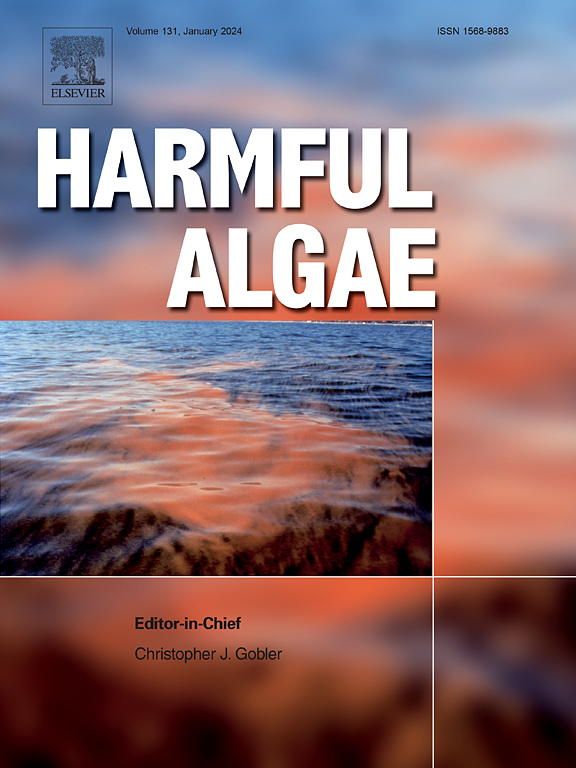热带珊瑚礁底栖有害鞭毛藻的分子多样性:利用DNA元条形码和形态分析比较自然和人工底栖取样方法
IF 5.5
1区 生物学
Q1 MARINE & FRESHWATER BIOLOGY
引用次数: 0
摘要
在全球气候变化的背景下,底栖生物系统中的有害藻华是全球范围内日益严重的一个主要环境问题。虽然已经推荐了基于细胞的BHAB系统监测风险评估和早期预警系统,但由于这些有害微藻分类群的底栖性质,标准化采样方法的实施具有挑战性。本研究利用人工底物(AS)和天然底物(NS)取样,结合环境DNA (eDNA)分析和针对小亚基(SSU)和大亚基(LSU) rDNA标记的高通量扩增子测序,研究了马来西亚Perhentian群岛热带珊瑚礁底栖有害鞭毛藻的分子多样性。我们的研究结果表明,AS方法有效地捕获了底栖鞭毛藻群落的一个代表性子集,在AS和NS之间具有显著的分类重叠。这两种标记都可以高分辨率地检测BHAB分类群,特别是冈比亚铁蒺藜和Ostreopsis,这两种生物很难通过光学显微镜进行鉴定。LSU rDNA标记提供了更精细的分类分辨率,捕获了更广泛的鞭毛类物种。分子方法与细胞定量数据一致,支持AS和DNA元条形码作为监测BHAB的可靠方法。这些发现强调了这些方法在早期检测方面的潜力,特别是在易受雪卡毒素和bhab相关中毒影响的地区,为常规细胞监测提供了一种系统的方法。本文章由计算机程序翻译,如有差异,请以英文原文为准。
Molecular diversity of benthic harmful dinoflagellates on a tropical reef: Comparing natural and artificial substrate sampling methods using DNA metabarcoding and morphological analysis
Harmful algal blooms in the benthic system (BHAB) are a major environmental problem that has increased worldwide in the context of global climate change. While systematic cell-based BHAB monitoring for risk assessment and early warning systems have been recommended, implementation of a standardized sampling method is challenging owing to the benthic nature of these harmful microalgal taxa. This study investigated the molecular diversity of benthic harmful dinoflagellates in tropical reefs of Perhentian Islands, Malaysia, using artificial substrate (AS) and sampling natural substrates (NS), combined with environmental DNA (eDNA) analysis and high-throughput amplicon sequencing targeting the small subunit (SSU) and large subunit (LSU) rDNA markers. Our results revealed that the AS method effectively captured a representative subset of the benthic dinoflagellate community, with significant taxonomic overlap between AS and NS. Both markers enabled high-resolution detection of BHAB taxa, particularly of Gambierdiscus and Ostreopsis, which are challenging to identify by light microscopy. The LSU rDNA marker provided finer taxonomic resolution, capturing a broader range of dinoflagellate species. The molecular approach consistently aligned with cell quantification data, supporting AS and DNA metabarcoding as robust methods for BHAB monitoring. The findings highlight the potential of these methods for early detection, especially areas susceptible for ciguatera and BHAB-related poisoning, offering a systematic approach for routine cell-based monitoring.
求助全文
通过发布文献求助,成功后即可免费获取论文全文。
去求助
来源期刊

Harmful Algae
生物-海洋与淡水生物学
CiteScore
12.50
自引率
15.20%
发文量
122
审稿时长
7.5 months
期刊介绍:
This journal provides a forum to promote knowledge of harmful microalgae and macroalgae, including cyanobacteria, as well as monitoring, management and control of these organisms.
 求助内容:
求助内容: 应助结果提醒方式:
应助结果提醒方式:


